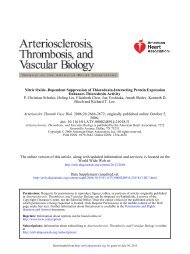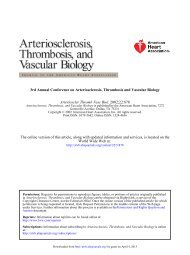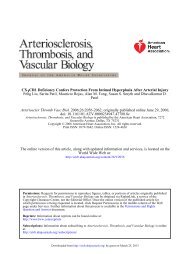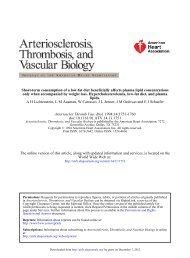Smooth Muscle Cells in Atherosclerosis Originate - Arteriosclerosis ...
Smooth Muscle Cells in Atherosclerosis Originate - Arteriosclerosis ...
Smooth Muscle Cells in Atherosclerosis Originate - Arteriosclerosis ...
Create successful ePaper yourself
Turn your PDF publications into a flip-book with our unique Google optimized e-Paper software.
<strong>Smooth</strong> <strong>Muscle</strong> <strong>Cells</strong> <strong>in</strong> <strong>Atherosclerosis</strong> Orig<strong>in</strong>ate From the<br />
Local Vessel Wall and Not Circulat<strong>in</strong>g Progenitor <strong>Cells</strong> <strong>in</strong><br />
ApoE Knockout Mice<br />
Jacob F. Bentzon, Charlotte Weile, Claus S. Sondergaard, Johnny H<strong>in</strong>dkjaer,<br />
Moustapha Kassem, Erl<strong>in</strong>g Falk<br />
Objective—Recent studies of bone marrow (BM)-transplanted apoE knockout (apoE / ) mice have concluded that a<br />
substantial fraction of smooth muscle cells (SMCs) <strong>in</strong> atherosclerosis arise from circulat<strong>in</strong>g progenitor cells of<br />
hematopoietic orig<strong>in</strong>. This pathway, however, rema<strong>in</strong>s controversial. In the present study, we reexam<strong>in</strong>ed the orig<strong>in</strong> of<br />
plaque SMCs <strong>in</strong> apoE / mice by a series of BM transplantations and <strong>in</strong> a novel model of atherosclerosis <strong>in</strong>duced <strong>in</strong><br />
surgically transferred arterial segments.<br />
Methods and Results—We analyzed plaques <strong>in</strong> lethally irradiated apoE / mice reconstituted with sex-mismatched BM<br />
cells from eGFP apoE / mice, which ubiquitously express enhanced green fluorescent prote<strong>in</strong> (eGFP), but did not f<strong>in</strong>d<br />
a s<strong>in</strong>gle SMC of donor BM orig<strong>in</strong> among 10 000 SMC profiles analyzed. We then transplanted arterial segments<br />
between eGFP apoE / and apoE / mice (isotransplantation except for the eGFP transgene) and <strong>in</strong>duced atherosclerosis<br />
focally with<strong>in</strong> the graft by a recently <strong>in</strong>vented collar technique. No eGFP SMCs were found <strong>in</strong> plaques that<br />
developed <strong>in</strong> apoE / artery segments grafted <strong>in</strong>to eGFP apoE / mice. Concordantly, 96% of SMCs were eGFP <strong>in</strong><br />
plaques <strong>in</strong>duced <strong>in</strong> eGFP apoE / artery segments grafted <strong>in</strong>to apoE / mice.<br />
Conclusions—These experiments show that SMCs <strong>in</strong> atherosclerotic plaques are exclusively derived from the local vessel<br />
wall <strong>in</strong> apoE / mice. (Arterioscler Thromb Vasc Biol. 2006;26:2696-2702.)<br />
Key Words: atherosclerosis smooth muscle cells adult stem cells pathology apoE knockout mice<br />
Recruitment of smooth muscle cells (SMCs) is a key<br />
mechanism <strong>in</strong> the development of atherosclerosis and its<br />
cl<strong>in</strong>ical manifestations. SMCs contribute to plaque volume<br />
through matrix synthesis, and the accretion of SMCs plays a<br />
decisive role <strong>in</strong> the pathogenesis of coronary stenosis. 1<br />
Conversely, paucity of SMCs <strong>in</strong> the fibrous cap of plaques<br />
<strong>in</strong>creases the risk of plaque rupture and life-threaten<strong>in</strong>g<br />
arterial thrombosis. 2 Understand<strong>in</strong>g the orig<strong>in</strong> of plaque<br />
SMCs may provide new opportunities for controll<strong>in</strong>g their<br />
ambiguous nature.<br />
See page 2579 and cover<br />
Until recently, the only source of SMCs <strong>in</strong> atherosclerotic<br />
lesions was considered to be the local vessel wall. Accord<strong>in</strong>g<br />
to this hypothesis, local SMCs <strong>in</strong> the arterial media and<br />
<strong>in</strong>tima modulate <strong>in</strong>to a synthetic and migratory phenotype<br />
(aka, phenotypic modulation3 ) and form the fibrous component<br />
of the plaque. This theory was essentially <strong>in</strong>ferred from<br />
a l<strong>in</strong>e of suggestive observations <strong>in</strong> arterial <strong>in</strong>jury models <strong>in</strong><br />
the 70s and 80s. 4,5 More to the po<strong>in</strong>t, Cre/lox fate mapp<strong>in</strong>g <strong>in</strong><br />
the apoE knockout (apoE / ) mouse model of atherosclerosis<br />
recently confirmed that preexist<strong>in</strong>g SMCs, presumably from<br />
the local media, contribute to plaque SMCs dur<strong>in</strong>g atherogenesis,<br />
but the existence of other sources could not be<br />
excluded by this technique. 6<br />
In 2002, an alternative and major source of SMCs <strong>in</strong><br />
atherosclerosis was reported, 7 and this new paradigm has<br />
great impact on current research <strong>in</strong> this area. 8,9 Based on<br />
observations <strong>in</strong> bone marrow (BM)-transplanted apoE /<br />
mice, it was concluded that a substantial fraction of plaque<br />
SMCs arise from circulat<strong>in</strong>g progenitor cells of hematopoietic<br />
orig<strong>in</strong>. 7 This pathway holds promise for the development<br />
of novel therapeutic means of controll<strong>in</strong>g the recruitment and<br />
accumulation of SMCs <strong>in</strong> plaques. However, it rema<strong>in</strong>s<br />
questionable whether the quality of the histological documentation<br />
<strong>in</strong> that study can support a def<strong>in</strong>itive conclusion,<br />
especially because the seem<strong>in</strong>g use of unfixed tissue for<br />
detection of enhanced green fluorescent prote<strong>in</strong> (eGFP) can<br />
lead to diffusion of the tracer marker from sectioned cells. 10<br />
Furthermore, reconstitution of apoE / mice with apoE /<br />
Orig<strong>in</strong>al received June 13, 2006; f<strong>in</strong>al version accepted September 13, 2006.<br />
From the Departments of Cardiology (J.F.B., E.F.), Aarhus University Hospital, and Institute of Cl<strong>in</strong>ical Medic<strong>in</strong>e, Aarhus University; the Department<br />
of Plastic Surgery (C.W.), Aarhus University Hospital; the Department of Molecular Biology and Institute of Cl<strong>in</strong>ical Medic<strong>in</strong>e (C.S.S.), Aarhus<br />
University; the Department of Gynecology and Obstetrics (J.H.), Aarhus University Hospital; and the Department of Endocr<strong>in</strong>ology (M.K.), Odense<br />
University Hospital, Denmark.<br />
Correspondence to Jacob Bentzon, MD, Department of Cardiology, Research Unit, Aarhus University Hospital, Brendstrupgaardsvej, 8200 Aarhus N,<br />
Denmark. E-mail jben@ki.au.dk<br />
© 2006 American Heart Association, Inc.<br />
Arterioscler Thromb Vasc Biol. is available at http://www.atvbaha.org DOI: 10.1161/01.ATV.0000247243.48542.9d<br />
Downloaded from<br />
http://atvb.ahajournals.org/ 2696 by guest on June 4, 2013














